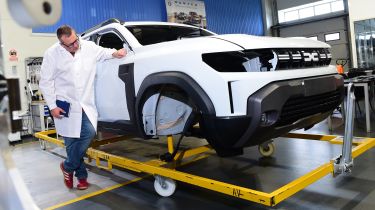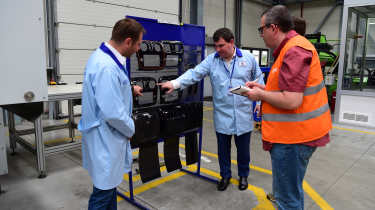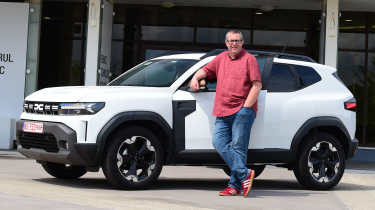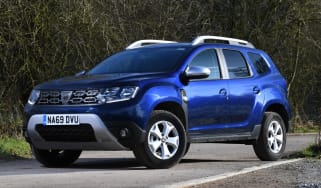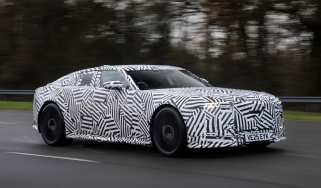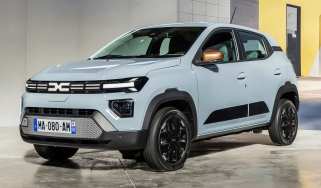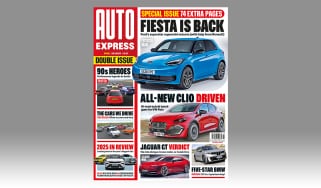Adding some Starkle to the Dacia Duster at a Bucharest bumper factory
We go behind the scenes with the Romanian firm that has been integral to the Duster’s development
Meet one of the unsung heroes of the new Dacia Duster. It’s not the idiot in the lab coat but rather the scruffy bodyshell behind him. For the past two years, it’s been hidden in an unassuming industrial unit in Titu, north-west of Bucharest in Romania. It’s here where Starkle, the unique plastic used in several of the new Duster’s exterior parts, has been turned from chemical theory into production reality.
This is the base of Metaplast, the partner trusted by Dacia’s parent Renault Group to make sure Starkle works. Family owned, it has, over the past 30 years, expanded from domestic appliances to automotive, and then developed its in house engineering skills so that it’s no longer a supplier, it has input into how parts are designed and made. This know-how was invaluable with Starkle.
To recap, the catchily named substance is an automotive-grade material containing around 20 per cent recycled content – around four times that in a typical plastic bumper. You’ll spot it on a new Duster because it has a distinctive light fleck that runs throughout the parts.
As we’re ushered into one of Metaplast’s nine manufacturing warehouses, the process laid out in front of us looks simple – or it would, were it not for the vast scale of some of the engineering involved.
The plastics, including Starkle, arrive in big containers as tiny pellets. These are then sucked up to drying chambers, where any excess moisture is removed, and then they’re sent down pipes that line the buildings’ walls to the injector. It’s here where these pellets are heated to more than 200 degrees, turning them into a liquid that can be injected into a pressurised mould – more than 2,700 tonnes for larger, more complex components. As soon as the part is formed, a built-in cooling system brings the temperature back down and a fresh piece trundles off the conveyer belt at around 30 degrees Celsius.
The basic treatment of Starkle is the same (although its melting point is 220 degrees), but it’s worth noting that the flecks don’t melt; they’re merely carried in the liquid plastic. It’s here where the expertise of Metaplast was invaluable, because it’s hard to ensure an even spread of speckles through the components – let’s call it consistent inconsistency – if you use conventional methods.
“First we studied Starkle in some of our existing processes, to see how it behaved,” says Anca Zuluf, Metaplast’s Chief Operations Officer. “We realised we had to redesign the mould and part, because if you inject the material from one end, you get uneven patches of the flecks. The answer was to have a more complex mould.”
Enter the Duster bodyshell. Delivered around 18 months before the car was revealed to the public, it was held in a room accessible to less than a dozen Metaplast staff. And this in a country where both the president and prime minister made it clear they wanted to have the first new-generation Duster.
Its presence was key, though, because it allowed Metaplast’s engineers to experiment with parts to ensure that components fitted perfectly, “The tolerance is basically zero,” says Project Manager Nicolae Ion. “With this bare shell, we were able to make parts to production standard and see how they fitted. It’s a good example of us being a partner on this car, more than a supplier.”
This status is clearly a matter of pride to Metaplast staff, led by the ebullient Jean Drugescu. “I can remember when we were making tiny parts,” the firm’s founder and president tells us. “These days we now spend around 5million Euros per year just on development, recruitment and so on, but it means we can be heavily involved in this type of project.”
There’s a real entrepreneurial spirit about Drugescu and his staff – a love of engineering and satisfaction taken by arriving at a solution, or finding a better one. “We don’t have 50 layers of management; we have small teams who think fast,” says Drugescu’s son Dragos, who is the firm’s marketing manager. “That makes us agile in a way a larger engineering division of a huge OEM might find difficult.” He’s not joking; on the production lines, Metaplast’s team can swap one 20-tonne part for another in 90 minutes – less than many an IT department needs to swap a printer toner cartridge.
There’s a lot of emotion rolled up in the Duster, too, because without it, Metaplast simply wouldn’t exist. “The [original] Duster is the model that made the ‘Big Bang’ for us,” Jean recalls. “Before that car, plastic parts were made by French companies who had set up in Romania. But with the Duster, we got the contract to produce many components – and it helped us to invest. We were the first Romanian company to be a tier-one supplier to a Renault-owned Dacia vehicle. Nowadays, I don’t think a single Dacia, with the possible exception of the [Chinese-built] Dacia Spring EV, doesn’t contain a part from us.”
Starkle is taking that involvement to a new level. “Before, we were usually doing parts that nobody sees,” Zuluf says. “But with Starkle, Dacia made a decision to make it visible; that’s huge for us.”
It’s not necessarily cheaper – for now, at least. Economies of scale may help when, as expected, Starkle features on the next Dacia Sandero and upcoming Bigster large SUV. But in the meantime, in its raw form it’s around 50 per cent more expensive than a conventional Renault Group black plastic.
Our tour ends in the bustling ‘Duster 3 hall’, built last year to cope with the demands of the new model. Here we see mighty machines turning out all four wheelarch surrounds from a single mould. It’s pretty much all running automatically, although it’s noticeable that human hands still touch every part off the line – fitting soundproofing material, or ensuring the requisite number of clips are attached, before the parts are slotted into the crates that will take them to Dacia’s factory in Mioveni.
Jean Drugescu can’t help but grin as he recalls the investment required to get to this point. “If I think back to the first Duster project,” he says with a nod to the production line, “the entire factory building probably cost less than a single one of those robots.” Further investment in the site is ongoing, not least to install as many solar panels as possible to help reduce energy costs. This is the second largest factor in the cost of a part, after raw materials.
People are another line on the profit and loss sheet, of course; the company employs around 1,600 staff, and its facilities include an on-site school. Indeed, one of Metaplast’s biggest challenges is to keep its staffing levels high enough to cope with demand. Romania’s still-emerging economy hasn’t always helped with this; Ion can name fully qualified engineers who’ve left promising positions at the company to travel to the UK and wash cars, just in search of harder currency. “It’s improving, but we still have many wives and girlfriends who work here while their husbands are abroad,” he acknowledges.
All the while, there’s a constant stream of chatter between the technicians in Metaplast’s own laboratory and their colleagues in Renault’s Romanian tech centre, which is conveniently located about 10 minutes’ drive away. A vast array of machines on both sites allows the boffins to take samples of all the materials and put them through hell – simulating up to seven years’ of exposure to the elements, including UV light and rain, in tests lasting three months.
It all adds up to a scratch-resistant bumper surface that blends sustainability, Dacia’s ‘waste not, want not’ approach and, yes, a look that’s subtly unique to every vehicle. But without that test bodyshell in a workshop in Romania, it couldn’t have happened at all.
How does the finished product perform? Take a look at our Dacia Duster owners' review...
Find a car with the experts

